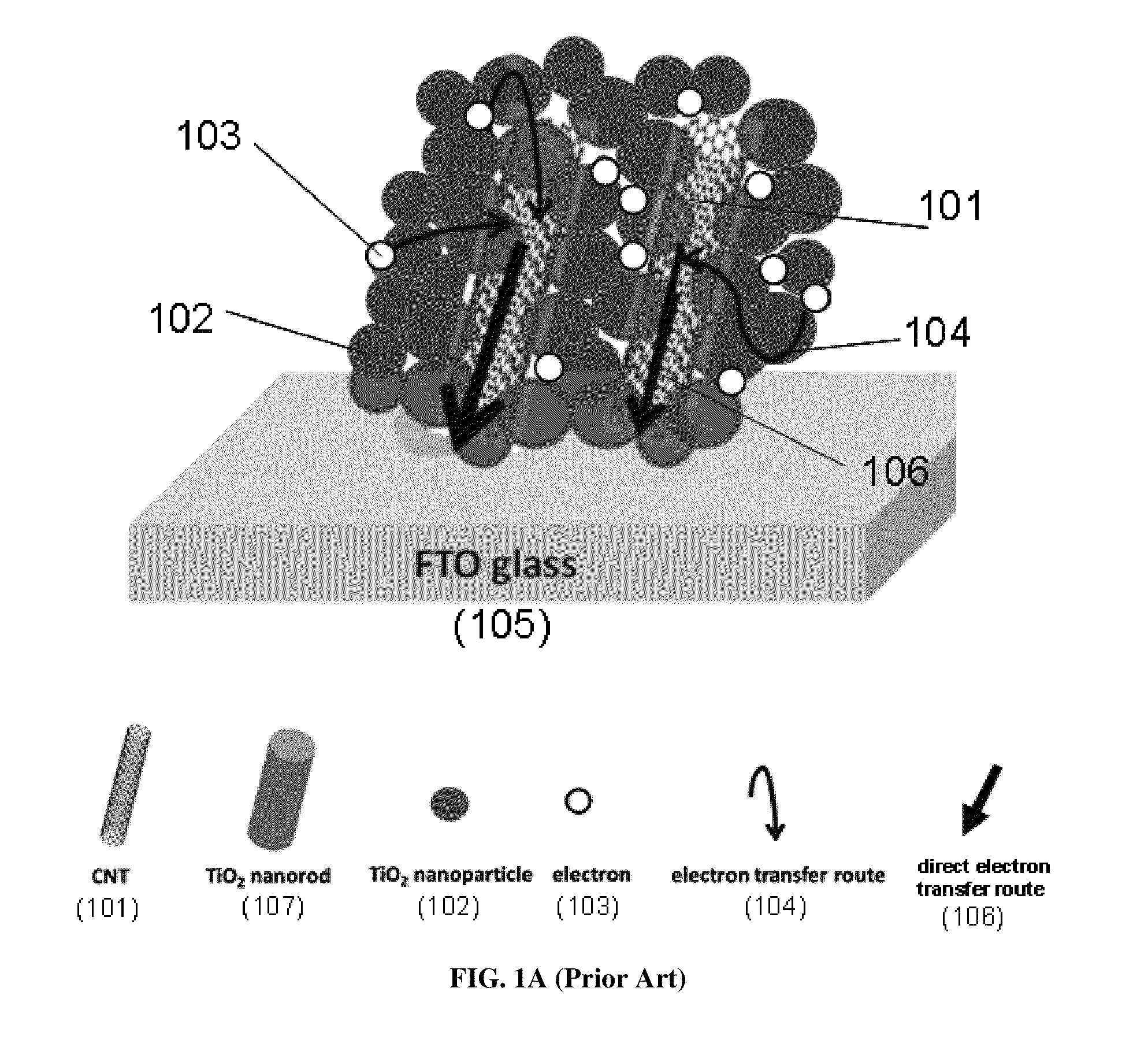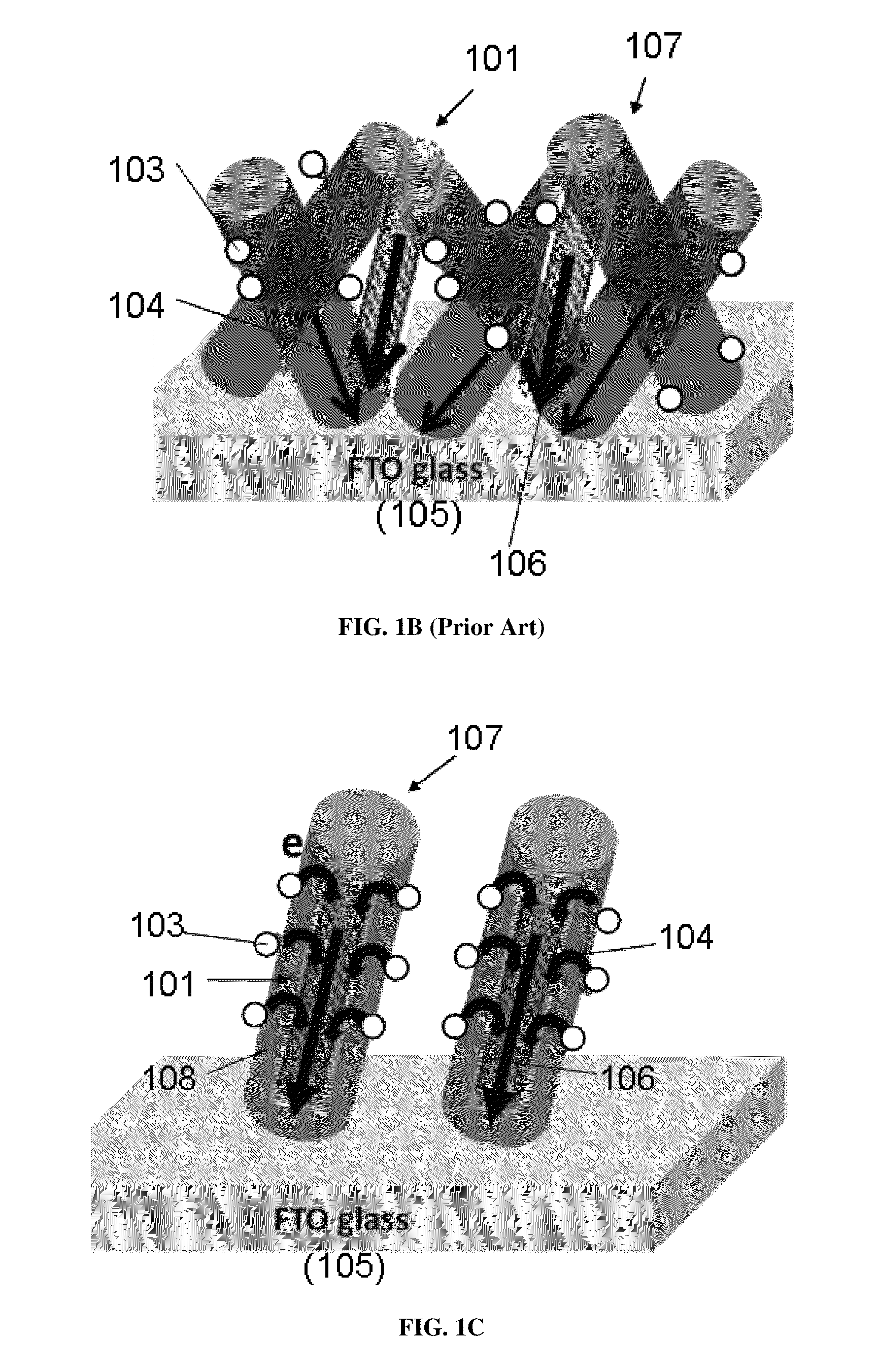Highly Conductive Nano-structures incorporated in Semiconductor Nanocomposites
a nano-composites, high-conductive technology, applied in the field of carbon-based nano-composites, can solve the problems of limited electron transport in nanoparticle-based devices, low efficiency, and low efficiency, and achieve the effect of reducing electron loss and improving charge transfer in semiconductor photoanodes
- Summary
- Abstract
- Description
- Claims
- Application Information
AI Technical Summary
Benefits of technology
Problems solved by technology
Method used
Image
Examples
example 1
[0069]TiO2 / PVP / MWCNT composite nanofibers were first electrospun on fluorine doped tin oxide (FTO) glass (15Ω per square) from a precursor solution that contained titanium isopropoxide (TIP, 4 g), polyvinylpyrrolidone (PVP, 3.5 g), acetic acid (2 g), MWCNT (0.05˜0.15 g) and ethanol (100 mL). All materials were obtained from Sigma-Aldrich and used without further purification. The voltage of 70 kV was applied over a collector distance of 19 cm. A layer of TiO2 / MWCNT nanorods was peeled off from the original FTO glass after calcination and then transferred to another FTO glass with an ultra-thin adhesive TiO2 paste. The TiO2 / MWCNT nanorod photoanode was obtained after calcinating at 450° C. for 2 h. The corresponding temperature rise rate was 1° C. / min until reaching the calcination temperature of 450° C. The thickness of the photoanode was measured by a surface profiler (TENCOR P-10).
[0070]Before sensitization, the photoanode (3 mm×3 mm) was first treated with an aqueous solution of ...
example 2
[0086]Similar to the experimental conditions of Example 1, the electrospun nanofibers were calcinated at the final temperature of 550° C. (for 2 h) instead of the optimal 450° C. as used in Example 1. Accordingly, three tests were carried out at 550° C. with a rate change in temperature of 1° C. / min, and with 0.1% wt MWCNTs in precursor solution Three samples A-C were obtained. It was expected that more rutile phase was found in the TiO2 nanofibers, which were unfavorable for the solar cell. Indeed, as shown on Table 3, tests on these samples A-C reveal lower fill factor less than 70% with exception of sample B, and lower short circuit density current (Jsc) falling short of 12 mAcm−2. The highest power conversion efficiency (PCE) corresponds to 5.54% which is only half of 10.24% obtained at the optimal condition with the final calcination temperature of 450° C.
TABLE 3VocJscFFPCESample[V][mAcm−2][%][%]A0.707.2161.823.12B0.7210.573.285.54C0.725.0863.152.31
example 3
[0087]After confirming the preferred optimal calcination temperature of 450° C. by keeping the rate of temperature change at 1° C. / min, additional tests were made at 450° C. but with the rate of temperature change increased to 3° C. / min. Four tests were carried out at 450° C. with a rate change in temperature of 3° C. / min, and with 0.1% wt MWCNTs in precursor solution. Four samples D-G were obtained. Firstly, the photoanodes (or composites) were observed to have cracks due to too rapid change in the oven temperature. The cracks in photoanodes are detrimental to performance of the solar cells. Indeed, Table 4 shows disappointing PCE less than 2.5% and much lower Jsc of less than 5.5 mAcm−2 despite the final calcination temperature being at the optimal value of 450° C.
TABLE 4ThicknessVocJscFFPCESample[μm][V][mAcm−2][%][%]D2.20.733.63591.56E16.90.715.47642.48F13.50.693.64471.19G6.50.704.28641.91
[0088]To conclude, workable DSSC cell can be produced with calcinations temperature between ...
PUM
 Login to View More
Login to View More Abstract
Description
Claims
Application Information
 Login to View More
Login to View More - R&D
- Intellectual Property
- Life Sciences
- Materials
- Tech Scout
- Unparalleled Data Quality
- Higher Quality Content
- 60% Fewer Hallucinations
Browse by: Latest US Patents, China's latest patents, Technical Efficacy Thesaurus, Application Domain, Technology Topic, Popular Technical Reports.
© 2025 PatSnap. All rights reserved.Legal|Privacy policy|Modern Slavery Act Transparency Statement|Sitemap|About US| Contact US: help@patsnap.com



